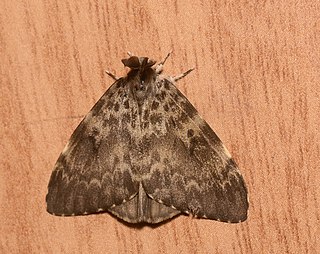
Lymantria is a genus of tussock moths in the family Erebidae. They are widely distributed throughout Europe, Japan, India, Sri Lanka, Myanmar, Java, and Celebes. The genus was erected by Jacob Hübner in 1819.

Aroa is a genus of moths in the subfamily Lymantriinae first described by Francis Walker in 1855. Species are distributed in South Africa, China, throughout India, Sri Lanka, Myanmar, and Java.

Lymantria concolor is a moth of the family Erebidae first described by Francis Walker in 1855. It is found in Sikkim, the Himalayas, Taiwan and Thailand.
Rajendra biguttata is a moth in the family Erebidae. It was described by Francis Walker in 1855. It is found from southern India to north-eastern India and in Bangladesh and Sri Lanka.

Tinolius eburneigutta is a moth of the family Erebidae first described by Francis Walker in 1855. It is found in India, Sri Lanka, and Thailand.
Aroa plana is a moth of the family Erebidae first described by Francis Walker in 1855. It is found in India and Sri Lanka. The caterpillar is known to feed on Bambusa species.
Aroa subnotata is a moth of the family Erebidae first described by Francis Walker in 1855. It is found in Sri Lanka.
Lacida costalis is a moth of the family Erebidae first described by Francis Walker in 1855. It is found in Sri Lanka.
Euproctis bimaculata is a moth of the family Erebidae first described by Francis Walker in 1855. It is found in India, Sri Lanka and Thailand.
Orgyia viridescens is a moth of the family Erebidae first described by Francis Walker in 1855. It is found in Sri Lanka.

Laelia testacea is a moth of the family Erebidae first described by Francis Walker in 1855. It is found in India and Sri Lanka.

Lymantria ampla is a moth of the family Erebidae first described by Francis Walker in 1855. It is found in India and Sri Lanka.
Lymantria fuliginosa is a moth of the family Erebidae first described by Frederic Moore in 1883. It is found in Sri Lanka and India.

Lymantria incerta is a moth of the family Erebidae first described by Francis Walker in 1855. It is found in India and Sri Lanka.

Lymantria marginata is a moth of the family Erebidae first described by Francis Walker in 1855. It is found in India, Bangladesh, Sri Lanka and Thailand.
Lymantria subrosea is a moth of the family Erebidae first described by Francis Walker in 1855. It is found from Sri Lanka to China and Sundaland, the Philippines, Sulawesi, Seram, the Lesser Sundas to Timor. The Sumatran population is categorized under the subspecies, Lymantria subrosea singapura.

Lymantria todara is a moth of the family Erebidae first described by Frederic Moore in 1879. It is found in India (Nilgiri) and Sri Lanka.
Callopistria apicalis is a moth of the family Noctuidae first described by Francis Walker in 1855. It is found in the Indian subregion, Sri Lanka, Sundaland and the Philippines.
Scopelodes venosa is a moth of the family Limacodidae first described by Francis Walker in 1855. It is found in Sri Lanka, China, India, northern Myanmar, northern Thailand, northern Laos, Vietnam and Nepal.

Narosa conspersa is a moth of the family Limacodidae first described by Francis Walker in 1855. It is found in Sri Lanka.










